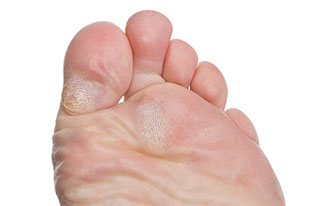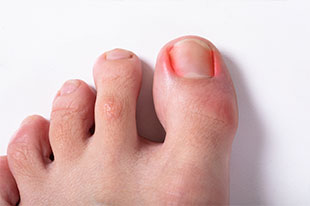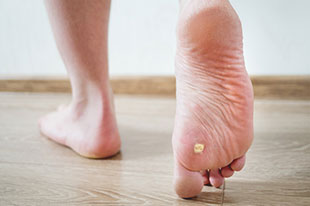Skin Conditions Treated
Podiatrists diagnose and treat many different types of skin disorders—some are nothing more than unsightly and mildly uncomfortable, while others can be painful and even potentially dangerous. Below are some of the most common skin issues of the feet.
Corns, Calluses, Blisters and Cracked Heels

Continued friction or pressure on the skin of the feet can cause corns, calluses and blisters. Corns and calluses cause the affected skin to harden. Corns have a hard center with swollen skin surrounding it and are usually smaller, deeper and sometimes painful, while calluses are larger and irregularly shaped. Your podiatrist may reduce your corn or callus by trimming or reducing it with a surgical blade or scalpel (respectively), treating it with medicated patches, pads or orthotics, or removing it surgically. With blisters, a protective bubble filled with serum is formed where the top layer of skin has separated from the underlying layers of skin. Your podiatrist may treat a blister by dressing it, offloading pressure from it with padding, and even treating it with antibiotics if it is infected. Cracked heels are caused when the skin on the heels becomes overly dry and pressure on them while standing causes them to split. These splits can deepen, bleed, and even become infected. Your podiatrist can treat cracked heels by carefully cutting off the layers of thickened, dead skin (debridement) and possibly finishing by sanding the cracks. If the heels are infected, the podiatrist will treat the infection and dress the area.
Infections, Ingrown Toenails, and Allergic Reactions

Various infections can affect the skin of the feet and the toenails. Athlete’s foot—tinea pedis—for instance, is a highly contagious fungal infection that creates an itchy, scaly rash in between the toes and feet, which a podiatrist may treat with prescription strength, topical anti-fungal creams, gels, powders or even anti-fungal oral medications. Toenail fungal infections cause toenails to become discolored, thickened, brittle and crumbled—even painful. They are also very difficult to treat at home, so your podiatrist can most effectively and permanently get rid of the fungus with prescription topical gels and creams, anti-fungal oral medications, or laser therapy. Ingrown toenails are painful and may become infected if not professionally treated by a podiatrist. It may be treated by removing the ingrown part of the nail, or lifting it so it grows properly, and even treating it medically if it is infected. Dermatitis is usually caused by an allergic reaction which can cause inflammation, redness, crusting, blistering, oozing, itching and dryness. A podiatrist can treat dermatitis with steroid medications, topical creams, and also oral medications.
Lesions and Warts

Foot lesions are marks or growths on the skin which can be due to hereditary conditions, infections, trauma, allergic reactions, bites, underlying medical conditions or even cancer (melanoma). Your podiatrist will take a small sample of the lesion’s tissue (biopsy) to properly diagnose the root cause of the lesion. How your podiatrist treats a lesion depends on their diagnosis, and can range from topical antibiotics/anti-fungals, to antimicrobial dressings, to cryotherapy, electrosurgery, or traditional surgery. Plantar warts (verrucas) are painful, thickened masses of skin on the bottom of the feet caused by the human papilloma virus, and are hard to get rid of. Your podiatrist may treat plantar warts with topical medications, cryotherapy, or laser therapy. If you have any type of skin issue on your feet, set up an appointment with your podiatrist who will examine, diagnose, and treat the issue accordingly.
